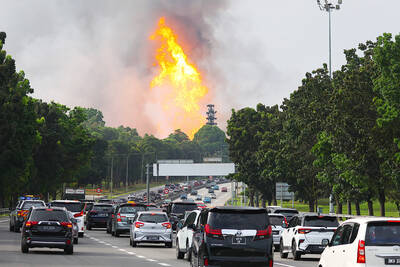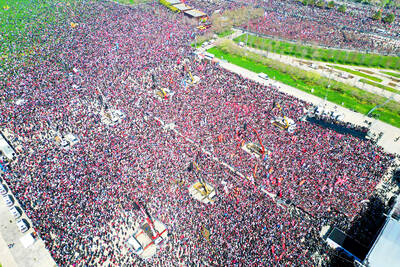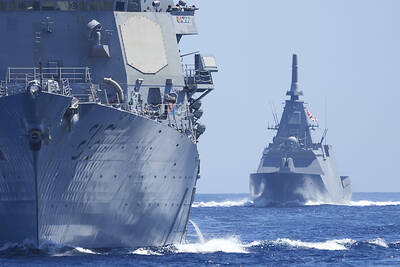As federal flood-control officials directed efforts on Thursday to block off the 17th Street Canal, the source of most of the water swamping New Orleans, they faced growing criticism over decades of missed opportunities to prevent precisely this kind of disaster.
In interviews and a telephone conference call with reporters, senior officials and engineers from up and down the ranks of the Army Corps of Engineers conceded that they had no ability to detect quickly small breaches in the matrix of 560km of levees around the city.
Unless such holes can be blocked early, the punch of storm-driven waters will almost invariably rip away at the edges, widening the breach.
The officials and engineers said that after they had found the widening gap in the concrete wall that lines the eastern side of the canal, they had no quick-response plan to repair it.
Even as they tried to improvise a solution, while fresh torrents of water steadily inundated neighborhood after neighborhood, their efforts were impeded by a lack of heavy helicopters, most of which had been dispatched by federal emergency management officials to rescue stranded residents.
"The first priority of the rotary-winged aircraft was to rescue people," Lieutenant General Carl Strock, head of the US Army Corps of Engineers, said in the conference call. "Plugging the gap was a lower priority."
The accumulation of 40 years of compromises of that sort on Thursday resulted in a mixture of grief, frustration and defensiveness from the Corps, which has long been given a mission far broader than its budget.
Ultimately, the Army Corps was being directed, along with 15 other agencies, by the Federal Emergency Management Agency (FEMA), Strock said.
"It is FEMA who is really calling the shots and setting priorities here," he said.
Strock also defended the administration against the idea that spending on Iraq had diminished the Corps capacity to deal with domestic threats like the hurricane.
"I do not see that to be the case," he said.
"We deeply regret the loss of life associated with this," Strock said. "We are committed to doing whatever we can right now to stop the flow of waters and get the city on the road to recovery."
Alfred Naomi, a Corps senior project manager in the New Orleans district, said the New Orleans protection system was a vexing mix: It met the standards that had long ago been agreed on, but it was known to be inadequate.
"This storm was much greater than protection we were authorized to provide," he said.
While Congress appropriated more than US$4.7 billion for the Corps of Engineers this year, the amount spent on the New Orleans levee projects highlighted by the flooding was relatively small. The Lake Pontchartrain project drew about US$5.7 million and that was almost US$2 million more than what US President George W. Bush recommended in his budget.
In the last five years, Congress has repeatedly raised the amount of money for levee projects in New Orleans over what Bush requested, according to numbers provided by Senate Republicans.
In fact, lawmakers repeatedly enlarged the corps' budget overall -- but it was always still far below what corps engineers said would finish the job.
Adam Hughes, a budget policy analyst with OMB Watch, said such tradeoffs far too often err on the side of serving short-term needs and discounting long-term risks. And now, he said, the destruction of New Orleans made an earlier investment in bigger berms and other protections -- all part of that gray universe of what bureaucrats call infrastructure -- look like a bargain.
"This is a classic example of what under-funding infrastructure can do," Hughes said.

A fire caused by a burst gas pipe yesterday spread to several homes and sent a fireball soaring into the sky outside Malaysia’s largest city, injuring more than 100 people. The towering inferno near a gas station in Putra Heights outside Kuala Lumpur was visible for kilometers and lasted for several hours. It happened during a public holiday as Muslims, who are the majority in Malaysia, celebrate the second day of Eid al-Fitr. National oil company Petronas said the fire started at one of its gas pipelines at 8:10am and the affected pipeline was later isolated. Disaster management officials said shutting the

US Vice President J.D. Vance on Friday accused Denmark of not having done enough to protect Greenland, when he visited the strategically placed and resource-rich Danish territory coveted by US President Donald Trump. Vance made his comment during a trip to the Pituffik Space Base in northwestern Greenland, a visit viewed by Copenhagen and Nuuk as a provocation. “Our message to Denmark is very simple: You have not done a good job by the people of Greenland,” Vance told a news conference. “You have under-invested in the people of Greenland, and you have under-invested in the security architecture of this

UNREST: The authorities in Turkey arrested 13 Turkish journalists in five days, deported a BBC correspondent and on Thursday arrested a reporter from Sweden Waving flags and chanting slogans, many hundreds of thousands of anti-government demonstrators on Saturday rallied in Istanbul, Turkey, in defence of democracy after the arrest of Istanbul Mayor Ekrem Imamoglu which sparked Turkey’s worst street unrest in more than a decade. Under a cloudless blue sky, vast crowds gathered in Maltepe on the Asian side of Turkey’s biggest city on the eve of the Eid al-Fitr celebration which started yesterday, marking the end of Ramadan. Ozgur Ozel, chairman of the main opposition Republican People’s Party (CHP), which organized the rally, said there were 2.2 million people in the crowd, but

JOINT EFFORTS: The three countries have been strengthening an alliance and pressing efforts to bolster deterrence against Beijing’s assertiveness in the South China Sea The US, Japan and the Philippines on Friday staged joint naval drills to boost crisis readiness off a disputed South China Sea shoal as a Chinese military ship kept watch from a distance. The Chinese frigate attempted to get closer to the waters, where the warships and aircraft from the three allied countries were undertaking maneuvers off the Scarborough Shoal — also known as Huangyan Island (黃岩島) and claimed by Taiwan and China — in an unsettling moment but it was warned by a Philippine frigate by radio and kept away. “There was a time when they attempted to maneuver